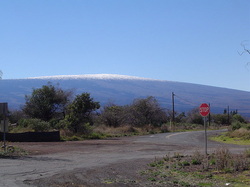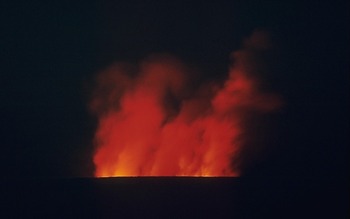|
Mauna Loa, a shield volcano of Hawaii, is the largest volcano on Earth with a volume of 80,000 km2. At ~4170 m above sea level it is not the tallest, however when you take into account the ~5000 m it stretches from the sea bed to sea level a grand total of more than 9000 m is obtained, which, if it wasn't for its neighbour Mauna Kea (at ~10,000 m) would make it the tallest volcano as well! Due to its size and weight it has also pushed down its base by a further 8 km, not a true height, but extremely interesting!  Mauna Loa This volcano was formed by a mantle plume (or hot spot) and evidence of the plume position can be seen at the surface and in the sea as the Hawaiian-Emperor Seamount Chain. As the Pacific plate moves and the mantle plume stays in roughly the same area a series of islands is created. In geological time, Mauna Loa is also relatively young at 200,000 years old and will probably become extinct within the next 500,000 to 1 million years. At the summit of Mauna Loa is the current Mokuaweoweo caldera around 5 km long and 3 km wide within an older and larger caldera. The last eruption of Mauna Loa occured in 1984 and was characterised by the usual mild explosive and effusive characteristics that are commonly seen on Hawaii. This included lava flows (aa and pahoehoe), hawaiian acitvity (fire fountaining) and strombolian activity. This post has probably not done Mauna Loa justice as it is an extremely interesting volcano with a more diverse history than can be fit into one post! There are many good sources of info including the Global Volcanism Program and the Hawaiian Volcano Observatory.
Comments are closed.
|
Archives
July 2023
|


 RSS Feed
RSS Feed